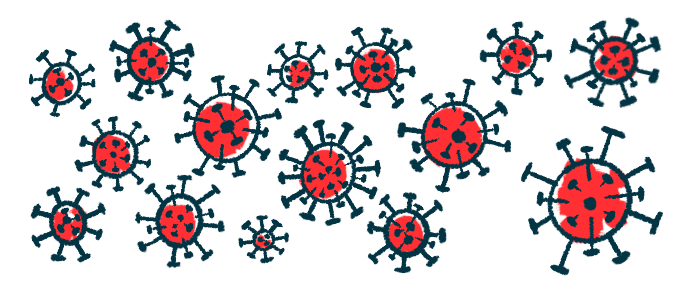Pro-fibrotic immune cell detected in lungs of long COVID-19 patients
Researchers analyzed data from 35 people with radiographic abnormalities
Written by |

Researchers have identified a type of pro-fibrotic immune cell associated with pulmonary fibrosis (PF) in people who develop persistent breathing problems after recovering from COVID-19. The cells’ abundance correlated with the severity of fibrosis, or tissue scarring, as detected by CT scans.
“The underlying cells and molecules that contribute to radiographic abnormalities in long COVID patients are now better established, and, equally important, it appears to be the same biological processes responsible for other types of lung injury that result in pulmonary fibrosis,” Marc Sala, MD, an associate professor of medicine at Northwestern University’s Feinberg School of Medicine in Chicago and the study’s senior author, said in a university news release. “This common denominator explanation may help not only in developing treatments for long COVID as it continues to evolve in the future, but also contributes to our understanding of pulmonary fibrosis due to other conditions.” Sala is also the co-director of the Northwestern Medicine Comprehensive COVID-19 Center and a pulmonary and critical care specialist at the Northwestern Medicine Canning Thoracic Institute.
The findings were reported in the study, “Profibrotic monocyte-derived alveolar macrophages are expanded in patients with persistent respiratory symptoms and radiographic abnormalities after COVID-19,” in Nature Immunology.
While most people recover from COVID-19, others develop persistent shortness of breath and cough, along with pulmonary fibrosis, or lung scarring, as seen on CT scans, a condition known as respiratory post-acute sequelae of COVID-19 (PASC) with radiographic abnormalities (RPRA), a type of so-called long COVID-19. Other manifestations of long COVID-19 include fatigue, trouble sleeping, rapid heart rate, and cognitive problems, such as memory loss and difficulty thinking or concentrating, or brain fog.
“Our understanding of long COVID is still in its early stages and there are no [U.S. Food and Drug Administration]-approved or even widely agreed-upon treatments for long COVID,” Sala said.
High levels of pro-inflammatory molecules
To understand which cells and molecules drive RPRA, Sala and his colleagues at Northwestern Medicine, collaborating with scientists at Brigham and Women’s Hospital, The Ohio State University, and Duke University, analyzed medical data from 35 people with RPRA, ages 32-83. About half were women (43%) and all had respiratory symptoms, including shortness of breath (97%) and cough (69%).
CT scans after COVID-19 showed signs of fibrosis (38.2%) and inflammation (22.3%), and about a third (31.6%) were classified as normal. Twenty nine patients had a second CT scan between about one to eight months later and 22 showed significant improvement, mainly due to reduced fibrosis. Seven patients, including two who needed a lung transplant, worsened.
An analysis of lung fluid, collected about five months to 1.5 years after COVID-19 infection, revealed the presence of high levels of pro-inflammatory molecules, leading to the ongoing migration of certain immune cells, such as neutrophils, monocytes, and macrophages, from the blood into the lungs. Moreover, the severity of CT scan changes correlated with the abundance of neutrophils and a type of macrophage called monocyte-derived alveolar macrophage, or MoAM.
A higher abundance of MoAMs significantly correlated with worse lung fibrosis in RPRA patients. Monocyte-derived macrophages are necessary for repair after injury in other tissues, but lung MoAMs cause fibrosis in mouse models, the researchers noted.
“What surprised us the most was the ongoing influx of pro-inflammatory and pro-fibrotic immune cells from blood into lungs even one year after the COVID infection. Historically, we assume infection-related lung inflammation resolves by this point,” Sala said. “The highly overlapping biological processes involving radiographic abnormalities and other non-COVID conditions that lead to fibrosis is an important finding.”
A gene activity analysis found that certain patterns in these MoAMs correlated with the severity of fibrosis, including genes implicated in fibrosis in mouse models. These gene activity patterns persisted regardless of whether patients improved, worsened, or remained the same.
Lastly, the researchers saw that elevated levels of pro-inflammatory signaling molecules, including CCL2, potentially produced by certain types of inflammatory immune cells in lung fluid, were linked to CT-detected lung fibrosis. The findings highlight MoAMs “as a biomarker of failed lung repair and a potential target for therapy,” they wrote.
“The more invisible manifestations of long COVID, such as brain fog, shortness of breath, rapid heart rate and fatigue, may well involve similar prolonged inflammation, and this study is an important step forward in supporting this idea,” Sala said. “The study also supports a broader point that understanding COVID and its ongoing impacts can serve to inform our understanding of other chronic respiratory illnesses that lead to pulmonary fibrosis.”







